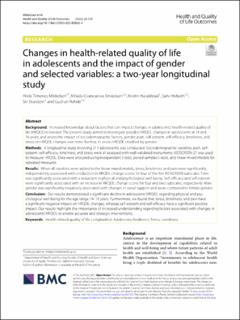Changes in health-related quality of life in adolescents and the impact of gender and selected variables: a two-year longitudinal study
Mikkelsen, Hilde Elisabeth Timenes; Småstuen, Milada Cvancarova; Haraldstad, Kristin; Helseth, Sølvi; Skarstein, Siv; Rohde, Gudrun E.
Peer reviewed, Journal article
Published version
Permanent lenke
https://hdl.handle.net/11250/3023492Utgivelsesdato
2022-08-18Metadata
Vis full innførselSamlinger
Originalversjon
Health and Quality of Life Outcomes. 2022, 20 . https://doi.org/10.1186/s12955-022-02035-4Sammendrag
Background: Increased knowledge about factors that can impact changes in adolescents’ health-related quality of life (HRQOL) is needed. The present study aimed to investigate possible HRQOL changes in adolescents at 14 and 16 years, and assess the impact of sociodemographic factors, gender, pain, self-esteem, self-efcacy, loneliness, and stress on HRQOL changes over time. Further, to assess HRQOL stratifed by gender. Methods: A longitudinal study involving 211 adolescents was conducted. Sociodemographic variables, pain, selfesteem, self-efcacy, loneliness, and stress were all assessed with well-validated instruments. KIDSCREEN-27 was used to measure HRQOL. Data were analyzed using independent t-tests, paired samples t-tests, and linear mixed models for repeated measures. Results: When all variables were added to the linear mixed models, stress, loneliness, and pain were signifcantly, independently associated with a reduction in HRQOL change scores for four of the fve KIDSCREEN subscales. Time was signifcantly associated with a reduction in physical and psychological well-being. Self-efcacy and self-esteem were signifcantly associated with an increase in HRQOL change scores for four and two subscales, respectively. Male gender was signifcantly negatively associated with changes in social support and peers compared to female gender. Conclusion: Our results demonstrated a signifcant decline in adolescents’ HRQOL regarding physical and psychological well-being for the age range 14–16 years. Furthermore, we found that stress, loneliness, and pain have a signifcant negative impact on HRQOL changes, whereas self-esteem and self-efcacy have a signifcant positive impact. Our results highlight the importance of increased understanding regarding factors associated with changes in adolescents’ HRQOL to enable accurate and strategic interventions.

